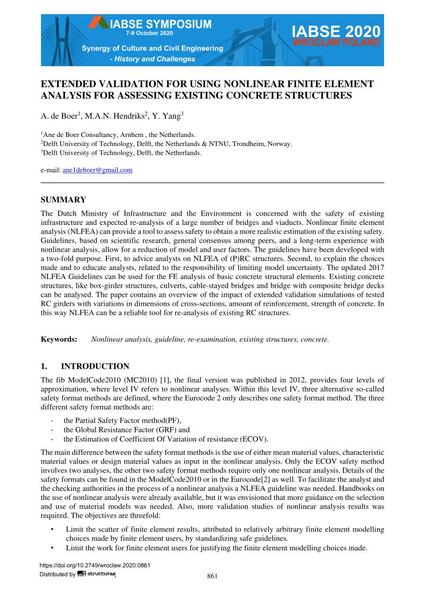Extended Validation for Using Nonlinear Finite Element Analysis for Assessing Existing Concrete Structures

|
|
|||||||||||
Bibliographic Details
| Author(s): |
A. de Boer
M. A. N. Hendriks Y. Yang |
||||
|---|---|---|---|---|---|
| Medium: | conference paper | ||||
| Language(s): | English | ||||
| Conference: | IABSE Symposium: Synergy of Culture and Civil Engineering – History and Challenges, Wrocław, Poland, 7-9 October 2020 | ||||
| Published in: | IABSE Symposium Wroclaw 2020 | ||||
|
|||||
| Page(s): | 861-868 | ||||
| Total no. of pages: | 8 | ||||
| Year: | 2020 | ||||
| DOI: | 10.2749/wroclaw.2020.0861 | ||||
| Abstract: |
The Dutch Ministry of Infrastructure and the Environment is concerned with the safety of existing infrastructure and expected re-analysis of a large number of bridges and viaducts. Nonlinear finite element analysis (NLFEA) can provide a tool to assess safety to obtain a more realistic estimation of the existing safety. Guidelines, based on scientific research, general consensus among peers, and a long-term experience with nonlinear analysis, allow for a reduction of model and user factors. The guidelines have been developed with a two-fold purpose. First, to advice analysts on NLFEA of (P)RC structures. Second, to explain the choices made and to educate analysts, related to the responsibility of limiting model uncertainty. The updated 2017 NLFEA Guidelines can be used for the FE analysis of basic concrete structural elements. Existing concrete structures, like box-girder structures, culverts, cable-stayed bridges and bridge with composite bridge decks can be analysed. The paper contains an overview of the impact of extended validation simulations of tested RC girders with variations in dimensions of cross-sections, amount of reinforcement, strength of concrete. In this way NLFEA can be a reliable tool for re-analysis of existing RC structures. |
||||
| Keywords: |
concrete guideline non-linear analysis existing structures re-examination
|
||||
